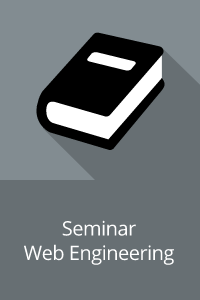
Seminar Web Engineering (WS 2020/2021)
Welcome to the homepage of the Seminar Web Engineering
This website contains all important information about the seminar, including links to available topics as well as information about the seminar process in general.
The interdisciplinary research area Web Engineering develops approaches for the methodological construction of Web-based applications and distributed systems as well as their continuous development (evolution). For instance, Web Engineering deals with the development of interoperable Web Services, the implementation of web portals using service-oriented architectures (SOA), fully accessible user interfaces or even exotic web-based applications that are voice controlled via the telephone or that are represented on TV and Radio.
The following steps are necessary to complete the seminar:
- Preparation of a presentation about the topic assigned to you.
- An additional written report of your topic.
- Each report is reviewed by two or three other particpants.
Seminar chairs

Contact
If you have any questions concerning this course or the exam as a participant, please contact us via OPAL.
We also offer a Feedback system, where you can provide anonymous feedback for a partiular session to the presenter on what you liked or where we can improve.
Participants
The seminar is offered for students of the following programmes (for pre-requisites, please refer to your study regulations):
- Bachelor Informatik (Proseminar 500110 /Hauptseminar 500070)
- Bachelor Angewandte Informatik (Proseminar 500110 / Hauptseminar 500270)
- Bachelor Informatik und Kommunikationswissenschaften (Hauptseminar 500070)
- Informatik für Sozial- und Geisteswissenschaftler (Proseminar 500110 /Forschungsseminar 500090)
- Master Informatik (Forschungsseminar M_01)
- Master Angewandte Informatik (Forschungsseminar 500090)
- Master Web Engineering (Seminar Web Engineering 500410)
If your programme is not listed here, please contact us prior to seminar registration and indicate your study programme, the version (year) of your study regulations (Prüfungsordnungsversion) and the module number (Modulnummer) to allow us to check whether we can offer the seminar for you and find an appropriate mapping.
Registration
You may only participate after registration in the Seminar Course in OPAL
The registration opens on 15.10.2020 at 12:00 and ends on 21.10.2020 at 23:59. There is an overall capacity of 30 slots available. As these slots are usually rather quickly booked, we recommend to complete your registration early after registration opens.Topics and Advisors
Questions:
- How can you include Forgiveness and Regret in a Content Trust Model?
- Why would these concepts enhance the Content Trust model?
Questions:
- What is it?
- How can it be implemented?
- How can it be applied to IoT application?
Literature:
- Domain-Driven Design:Tackling Complexity in the Heart of Software, Eric Evans
Questions:
- What is it?
- How to provide contextual information (e.g., location) to other applications?
- What are the advantages compared to other existing solutions?
Questions:
- What is Object Detection?
- What are state of the art solutions?
- Provide a structured comparison of general purpose object detection in images vs UI object detection in Web User Interfaces (characteristics that make it easier such as lack of light differences, perspectives, noise etc. and characteristics that make it harder e.g. high visual similarity of UI objects, small size of objects, background images etc.).
Literature:
- Felzenszwalb HOG, RPNs, Faster RCNN, Mask RCNN, YOLO, Browserbite
- https://arxiv.org/pdf/1803.02129.pdf
- https://blog.athelas.com/a-brief-history-of-cnns-in-image-segmentation-from-r-cnn-to-mask-r-cnn-34ea83205de4
- https://acadpubl.eu/hub/2018-118-24/4/694.pdf
Questions:
- What are established export formats for digital scientific datasets?
- What are their advantages and how do they compare to each other?
- Which of these formats relies on Linked Data and which vocabularies are used for that?
Literature:
- Own research
Questions:
- Why is data quality in the meta-description of published scientific files important?
- What is the FAIRmetrics project and how can these metrics be implemented and measured?
- What are other data quality metrics that are relevant for research file meta descriptions?
Questions:
- What is the idea of a Knowledge Graph for Research?
- Which vocabularies and technologies do they use?
- What are alternative approaches, such as the Microsoft Academic Knowledge Graph, and how do they compare to each other?
Questions:
- What is the motivation for synthesizing training dataset? Where has this been applied successfully? How does it relate to Transfer Learning?
- What are common approaches for training dataset synthesis? How is a high similarity with the equivalent real data measured and ensured? How are Generative Adversarial Network (GANs) used for training dataset generation?
- Which characteristics (e.g. variance, parameter distributions, required dataset size, measures to ensure close reproduction of reality etc.) are required/suitable for dataset synthesis? Are there studies investigating general rules/limitations/recommendations for applicability?
Literature:
- https://arxiv.org/abs/1603.07057
- https://arxiv.org/abs/1904.11621
- https://arxiv.org/abs/1807.07521
- https://dl.acm.org/doi/10.1145/3290607.3312994
- VISH: Does Your Smart Home Dialogue System Also Need Training Data?
- https://arxiv.org/abs/1707.07410
- https://arxiv.org/abs/1703.06907
- https://arxiv.org/abs/1808.06910
- https://ai-alignment.com/synthesizing-training-data-f92a637dc1b4
- https://towardsdatascience.com/synthetic-data-generation-a-must-have-skill-for-new-data-scientists-915896c0c1ae
- https://www.technologyreview.com/2016/09/12/157605/self-driving-cars-can-learn-a-lot-by-playing-grand-theft-auto/
Questions:
- What are the benefits?
- How does it compare to our design patterns?
- What are it's application in microservices?
- How can it be applied to IoT devices, and what are the existing scientific works on this topic?
Questions:
- Give an introduction to Microservices. What types of software architectures based on microservices are there?
- Provide an overview on current microservice patterns, categorise and group them, provide examples.
- For what type of applications are microservice architectures and patterns useful, for which not?
Literature:
- https://microservices.io/patterns/microservices.html
- https://www.youtube.com/watch?v=CZ3wIuvmHeM
- https://netflixtechblog.com/tagged/microservices
- https://katalog.bibliothek.tu-chemnitz.de/Search/Results?lookfor=microservice&s=
- https://apps.webofknowledge.com/Search.do?product=WOS&SID=F4KQdsg2wxhna5aoqBC&search_mode=GeneralSearch&prID=5eeedb59-d03c-4742-81b5-0c3079413546
Questions:
- Provide an introduction to Kubernetes.
- When to use plain docker, when Kubernetes, when none of them? What are alternatives to Kubernetes? What are typical application sizes and hardware setups/requirements when using Kubernetes?
- Create a demo that showcases the use of Kubernetes for the deployment and scaling of a multi-platform web application.
Questions:
- Provide a brief introduction to the problem of Quality Control in Crowdsourcing
- What are common approaches for Quality Control in Crowdsourcing, how can they be grouped, when to use which approach?
- Find existing empirical studies on Quality Control methods/mechanisms, the quality/success metrics that they use and current values they achieve in those.
Questions:
- What are research scenarios, where data files are generated in the interaction between a human and a computer (such as a robot, a smart device, a motion tracker, a VR glass, a 3D model, ...)?
- Which standardised vocabularies already exist in these disciplines to describe relevant characteristics of scientific data files?
- Find or create a SKOS representation of these terminologies and import it into a terminology service such as TISAF.
Literature:
Questions:
- Why is additional structured meta information necessary that describes scientific files as a result of a research activity?
- Which established file formats and standards exist to describe such a research file in a structured way, that make use of Linked Data?
- How can such a file be generated?
Literature:
- Own research
Questions:
- What are the FAIR principles and what are the CARE principles?
- How can they particularly be applied for publishing research files?
- Which tools exist that can assist a user and assess the quality of the provided file meta information?
Literature:
- Own research
Questions:
- What is the data-structure of a .dxf file?
- How can you reformat this information into an .osm - file (XML-file with OpenStreetMap markup)?
- Write an algorithm that transforms simple structure elements (walls, grounds, doors) from .dxf to .osm and demonstrate this algorithm. You can use the existing, but dated, .dxf to .osm plugin for JOSM (link below) as a basis for this.
Literature:
- https://www.openstreetmap.org
- https://wiki.openstreetmap.org/wiki/OSM_XML
- https://wiki.openstreetmap.org/wiki/JOSM/Plugins/DXF_import
- https://github.com/JOSM/Dxf-Import
Questions:
- What are geospatial databases? How do they work?
- Compare different geospatial databases about: Language, licence/prices, etc
- What is an easy tool that you can use as a geospatial database? Explain your reasoning!
Questions:
- What are the common and what are the special design characteristics of web-based testbeds?
- Which artifacts qualify a testbed to be developed web-based?
- What are current limitations in web-based testbeds?
Literature:
- own research
Questions:
- What must be considered when you develop a geodatabase for an indoor environment?
- Can you use an OSM-file (OpenStreetMap) as input for this database?
- Build a small geospatial databank for an indoor environment by using geospatial information about the rooms and the position of the furniture. Add to this additional information about the surroundings (e.g. about doors, stairs, furniture,...). Find other relevant information that you can add!
Questions:
- What is it?
- How is it possible to avoid oversampling?
- How is data augmentation performed for natural language text?
Literature:
- own resources
Questions:
- Where can we find scientific files from experiments that deal with human-technology-interaction and how are they commonly described?
- Which aspects are commonly described for such a data based on knowledge-domain specific requirements?
- Conduct a systematic search about existing taxonomies for that.
Literature:
Seminar Opening
The seminar opening will be held on Tuesday, 27/10/2020 virtually at 17:15 via TU-Chemnitz BigBlueButton. You weill find more information on the room via OPAL.
Short Presentation
In your short presentation, you will provide a brief overview on your selected topic.
This includes the following aspects:
- What is in your topic?
- Which literature sources did you research so far?
- What is your idea for a demonstration?
The short presentation should be no longer than 3 slides (in addition to your title slide) and take max. 5 minutes. Following your short presentations, the advisors will provide you with feedback and hints for your full presentations.
Hints for your Presentation
- As rule of thumb you can plan for 2 minutes per slide. Significantly more slides per minute can be difficult to perceive for the audience.
- Prior to creating your presentation, you should think about: What should be the main message of my presentation? What should the audience remember after my presentation?
Based on these considerations you should create your presentation. - Here you can find some useful hints http://www.garrreynolds.com/Presentation/
Seminar Days
Report
- Important hints on citing:
- Any statement which does neither belong to general knowledge nor stem from the author has to be provided with a reference to its original source.
- "When to Cite Sources"- Good overview by Princeton University
- Examples for citations can be found in the IEEE Citation Reference
- Web References have to be cited with author, title, date, URL and date of last access. Examples:
- [...] M. Nottingham and R. Sayre, "The Atom Syndication Format - Request for Comments: 4287", 2005. [Online]. Available: http://www.ietf.org/rfc/rfc4287.txt. [Accessed: Feb. 18, 2008].
- [...] Microsoft, "Microsoft Office SharePoint Server 2007 Homepage", 2007. [Online]. Available: http://office.microsoft.com/en-us/sharepointserver/. [Accessed: Jan. 02, 2007].
- The url has to be included as a hyperlink ("clickable") if technically possible.
- Further Information and Hints:
- Please use, as far as possible, the HTML elements which are used in the template. Changes to the CSS file are not allowed and will be ignored.
- Carefully check spelling and grammar of your reports, preferably using software support such as OpenOffice, Microsoft Word or LanguateTool, before uploading it.
- Check that your HTML is valid using the W3C Validator
Review
- Each seminar participant has to review exactly three reports. The reviews are not anonymous.
- Use the review forms provided in the VSR Seminar Workflow, one per report.
- Following the review phase, each seminar participant will receive the three peer reviews of his report and, if necessary, additional comments by the advisors. You will then have one more week to improve your report according to this feedback.
- The seminar grade will consider the final report.
All comments in the reviews are for improving the text and therefore in the interest of the author.


